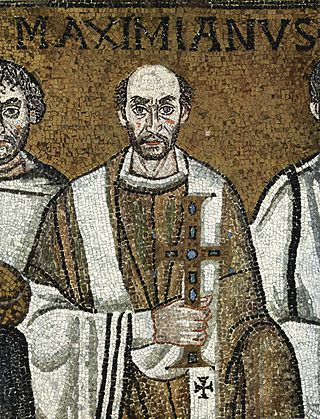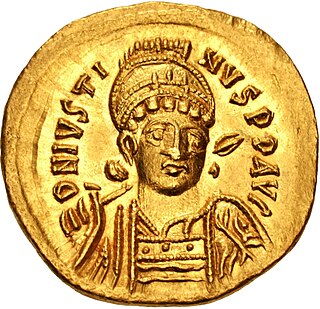
Anastasius I Dicorus was Eastern Roman emperor from 491 to 518. A career civil servant, he came to the throne at the age of 61 after being chosen by Ariadne, the wife of his predecessor, Zeno. His reign was characterized by reforms and improvements in the empire's government, finances, economy and bureaucracy. The resulting stable government, reinvigorated monetary economy and sizeable budget surplus allowed the empire to pursue more ambitious policies under his successors, most notably Justinian I. Since many of Anastasius' reforms proved long-lasting, his influence over the empire endured for centuries.
The 510s decade ran from January 1, 510, to December 31, 519.

Year 544 (DXLIV) was a leap year starting on Friday of the Julian calendar. The denomination 544 for this year has been used since the early medieval period, when the Anno Domini calendar era became the prevalent method in Europe for naming years.

Year 556 (DLVI) was a leap year starting on Saturday of the Julian calendar. The denomination 556 for this year has been used since the early medieval period, when the Anno Domini calendar era became the prevalent method in Europe for naming years.

Justin I, also called Justin the Thracian, was Eastern Roman emperor from 518 to 527. Born to a peasant family, he rose through the ranks of the army to become commander of the imperial guard and when Emperor Anastasius I Dicorus died, he out-maneouvered his rivals and was elected as his successor, in spite of being around 68 years old. His reign is significant for the founding of the Justinian dynasty that included his eminent nephew, Justinian I, and three succeeding emperors. His consort was Empress Euphemia.

Theodosius III was Byzantine emperor from c. May 715 to 25 March 717. Before rising to power and seizing the throne of the Byzantine Empire, he was a tax collector in Adramyttium. In 715, the Byzantine navy and the troops of the Opsician Theme, one of the Byzantine provinces, revolted against Emperor Anastasius II, acclaiming the reluctant Theodosius as emperor. Theodosius led his troops to Chrysopolis and then Constantinople, the capital, seizing the city in November 715. Anastasius did not surrender until several months later, accepting exile in a monastery in return for safety. Many themes viewed Theodosius to be a puppet of the troops of the Opsician Theme, and his legitimacy was denied by the Anatolics and the Armeniacs under their respective strategoi (generals) Leo the Isaurian and Artabasdos.
The Henotikon was a christological document issued by Byzantine emperor Zeno in 482, in an unsuccessful attempt to reconcile the differences between the supporters of the Council of Chalcedon and the council's opponents. It was followed by the Acacian schism.
Germanus was an Eastern Roman general, one of the leading commanders of Emperor Justinian I. Germanus was Emperor Justinian's cousin, thus also a member of the ruling dynasty. He held commands in Thrace, North Africa, and the East against Persia, and was slated to command the final Byzantine expedition against the Ostrogoths. Having married into the Gothic Amal royal line through his second wife Matasuntha and a distinguished service record, at the time of his sudden death, he was considered the probable heir to Emperor Justinian.

The Leonid dynasty or Thracian dynasty produced six Roman emperors during Late Antiquity, reigning over the Roman Empire from 457 to 518. The dynasty's patriarch was Leo I, who was made Roman emperor in 457. Leo's daughter Ariadne became empress and mother to an emperor, and her two husbands were themselves each made emperor in turn. Another relative whose name does not survive of Leo I or his wife Verina married the future augustus Julius Nepos, the last emperor in the Western Roman Empire. The dynasty of Leo succeeded the preceding Valentinianic dynasty and Theodosian dynasty whose family trees were conjoined and ruled concurrently. Besides Julius Nepos, who administered no more than a rump state the Roman province of Dalmatia in the western empire during the fall of the west, the dynasty's emperors governed the eastern empire.
Justinian was a Byzantine aristocrat and general, and a member of the ruling Justinian dynasty. As a soldier, he had a distinguished career in the Balkans and in the East against Sassanid Persia. In his later years, he plotted unsuccessfully against regent and later emperor Tiberius II.
Vitalian was a general of the Eastern Roman Empire. A native of Moesia in the northern Balkans, and probably of mixed Roman and Gothic or Scythian barbarian descent, he followed his father into the imperial army, and by 513 had become a senior commander in Thrace.
Flavius Patricius was a prominent Eastern Roman general and statesman during the reign of Byzantine emperor Anastasius I.
Germanus was a Caesar of the Byzantine Empire. He married Charito, a daughter of Tiberius II Constantine and Ino Anastasia.
Pompeius was a politician of the Eastern Roman Empire and nephew of the Emperor Anastasius I. His family gained political prominence with the accession of Anastasius. Pompeius was consul in 501, and was elevated to the patricianate, probably by Anastasius. He held military office, serving in the Iberian War. He married a woman named Anastasia, and had at least one son. In 532, Pompeius' brother Hypatius was acclaimed emperor by the rioters during the Nika riots; after the riots were put down, both Hypatius and Pompeius were executed.
Flavius Domnicus was a Byzantine military officer and patrikios, active in the reign of Emperor Justinian I. He should not be confused with his contemporary Domnicus, Praetorian prefect of Illyricum.
Marinus was one of the most trusted and senior aides of the Eastern Roman emperor Anastasius I. He served twice as the praetorian prefect of the East, supervised some of Anastasius's tax reforms, supported the Emperor's pro-Monophysite policies and led the Roman navy in a crucial battle that ended the rebellion of general Vitalian in Thrace decisively. He survived into the regime of Justin I, when he served his second tenure as the praetorian prefect, but was soon sidelined from power and died sometime before 539 AD.

John, also known as John the Sanguinary, was the nephew of the rebel Vitalian and was an Eastern Roman general under Justinian I, who was active in the Gothic War in Italy and against the Gepids in the western Balkans. He was married to Justina, the daughter of Justinian's cousin Germanus.
The quaesitor was a Late Roman/Byzantine police official of Constantinople, specifically a magistrate, responsible for controlling the flow of legal and illegal immigration into the capital city of Byzantium. The office of the quaesitor was first established in 539 through the Novella 80 of Emperor Justinian I, designed to deal with the arrival of unemployed people to Constantinople living as criminals or beggars. One of his functions was to investigate people passing through Constantinople by determining their names, origins, and reasons for being in the city. Furthermore, the quaesitor had the authority to deal with unemployed persons by forcing the physically fit among the unemployed to work in a public industry such as a bakery. The quaesitor was also granted judicial functions whereby his court dealt with certain types of crimes such as forgery.
Amantius was the head chamberlain of the Byzantine emperor Anastasius I. Defeated by Justin I in the intrigues and power struggles after Anastasius' death, he was executed.
Tarrach was a Hun military officer for the East Roman Empire. He was the assassin of the officer Cyril. Tarrach was credited as the "fiercest of the Huns".






